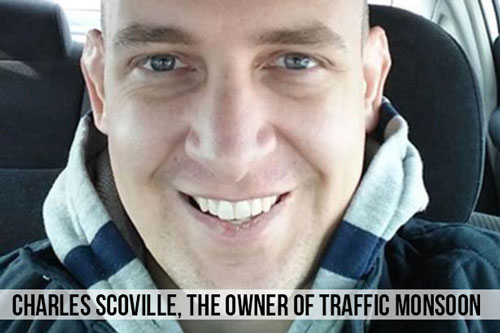Traffic Monsoon – is it a scam?
Is TM actually a Ponzi Scheme? In this update we’ll do a review of what’s going on with Traffic Monsoon (TM) and why you should pay attention.
I am sure you’d agree with me that losing your hard earned money to a scam feels pretty bad. In this post we’ll be talking about TM and how thousands of people lost their money to this program. Get a cup of hot brew, get comfortable, this won’t be pretty.

What is Traffic Monsoon
For those who’ve never heard of TM, let me take a quick minute to explain what it is (or was?)
Traffic Monsoon is advertised as an advertising and revenue sharing company. TM promised to bring traffic to your website for very cheap. Besides, they position themselves as a revenue sharing company where members get a part of what the site earns, it also offered a PTC (paid to click) program for free and paid members.
Traffic Monsoon launched in October 2014. In July of 2016 SEC (Securities and Exchange Commission) sued to shut down Traffic Monsoon LLC, the agency called an “ongoing Ponzi scheme” that has taken over $200 million from 162,000 investors.
So let’s look deeper into how money was being geerated within Traffic Monsoon.
Paid To Click
You could become a free member of TM and “make money” within their PTC program. Every day you would have to click on 10 ads (and spent 20 seconds on the website where the ad takes you) and you would earn … $0.01. Yes, that’s one penny for a total of 10 cents per day. Some might argue that it only takes 5 minutes of work though. Okay, this means you’re earning an hourly wage of $1.20. Impressed? Neither am I.
The whole traffic exchange part of the system was completely useless just like in any other traffic exchange. If you have your ads displayed on such site people only click on these ads to get their penny, they do not care about your product, service, website content, in fact they can’t wait until the 20 seconds pass so they could click on the next ad and be done with it.
People aren’t stupid. They wouldn’t waste their time earning 10 cents per day. This is when AdPacks come in.
Traffic Monsoon AdPacks
To earn real money within TM you’d have to buy AdPacks at $50 each. An adpack gives you access to the revenue sharing program of TM. An average earning from an AdPack is claimed to be $1 per day on average although Traffic Monsoon does not guarantee that amount. Your adpack expires in 55 days so you will earn $55 (or less). Take away your original investment of $50 and you made a profit of $5 in 55 days. In order to be eligible for the $1 per day per adpack share you will need to click on 10 ads per day, every single day.
Traffic Monsoon Referral Program
TM also offered 10% commission for recruiting new AdPack members. If you refer a new member who would buy 1 adpack you’d make a $5 commission (a typical affiliate system, Amazon, Walmart and many other companies have affiliate programs as well).
Why is SEC trying to shut it down?
Traffic Monsoon positions itself as an advertising company that sells advertising services (ex: their traffic exchange). However, SEC established that 99.6% of Traffic Monsoon’s income comes from the investor, aka people why buy the adpacks. Not from actually selling any products or services. Do you see the problem yet?
P.S. SEC has requested documents from the TM’s CEO for the investigation. These documents revealed the actual sources of company’s income and this is where the documents made it clear that only 0.4% of Traffic Monsoon’s income comes from selling advertising services.
Let’s do simple math.
Let’s say you bought 1 single AdPack for $50. Within 55 days your account shows $55. Where does Traffic Monsoon take that $55 to pay you? They are basically giving you your $50 back and they also owe you another $5 which they do not have. In order to pay you they sell another AdPack to another person, they give your $5 but when the time comes to pay the new member they are now $10 short, because they paid you $5 from this guy’s $50, leaving them with $45 and they owe the new guy $55… so they sell another AdPack. And this, ladies and gentlemen is the definition of a Ponzi scheme.
Now, let’s imagine that you also recruit just 1 new AdPack members this means that TM also owes you $5 referral fee. So your initial investment of $50 has earned you a $10 profit. Money that comes out of the next guy’s AdPack because TM doesn’t have any other source of revenue.
Traffic Monsoon cannot pay all its members what they earn because there is a constant shortage of cash which they cover by constantly selling more and more adpacks.
Sure, many members were able to pull out their earnings because the new members kept coming in and fueling the fire with their hard earned money.
PayPal takes notice
On January 11th of 2016 Paypal places a temporary hold on Traffic Monoon’s account for 1 month. This means that the money can come into the Paypal account but cannot come out. Paypal froze the account because it noticed an incredibly high influx of money with no chargebacks and refunds. PayPal explains that such behavior reeks of a ponzi scheme so they place a hold on the money inside the account in case the company (TM in this case) does end up being a fraud and all of the sudden the clients would start asking for their money back.

Instead of telling the truth to TM investors, the owner and founder Charles Scoville told everyone that he is simply switching the payment processor. Loads of members kept buying AdPacks, without knowing that their funds are being frozen by PayPal.
On February 11th Paypal extends the hold on TM’s account for another 5 months. Scoville finally admits that over $60Million has been frozen by Paypal because of “company’s rapid growth and Paypal not being able to handle it”.
When PayPal finally takes the hold off of the account on July 11th, Charles decide to withdraw all the money himself instead of paying out the Traffic Monsoon members. $25 million gets transferred to Traffic Monsoon’s JPMorgan Chase Bank account and from that Scoville immediately transfers $21 Million into his personal bank account. He tries to withdraw more money from Paypal but the company doesn’t allow him to. On July 12th Scoville announces to his members that the funds will be released by Paypal on August 11th. Yes, he withdraws the money and the very next day says to his members that the funds are still frozen within Paypal for another month or so.
SEC steps in
Shortly after the Paypal hold the SEC has requested a Traffic Monsoon Receiversip be established. SEC also froze all accounts owned by Traffic Monsoon and Charles Scoville. If SEC didn’t step in there is a chance all of this money would have ended up in some offshore account. The Receiverhip will distribute whatever’s left in TM accounts among members who lost their money to this ponzi scheme. Needless to say it will be only a fraction of what these people gave to TM.
How can Traffic Monsoon members get their money back?
The simple answer is – they can’t, at least not yet. The receivership website has been set up and if you lost money with TM you should definitely contact them, although they probably have TM’s database of users and the money paid by the user and to the user.
If you have paid by Paypal, Payza or SolidTrust you should request a refund. If this doesn’t work, contact your bank’s fraud department and request a chargeback. If that doesn’t work than get in touch with the receivership mentioned above and hope for the best.
Why Are TM Members Defending Traffic Monsoon?
There are over 160,000 TM members. Many invested very large sums of money into TM and as they are slowly realizing that money might be completely lost, they enter the denial stage. Some members have been shouting that the whole thing is a huge conspiracy theory set-up by Paypal and SEC “because everyone wants a piece of TM pie”.
SEC does not want any of that. When the dust settles SEC will redistribute all of that money among the members of Traffic Monsoon. Paypal doesn’t gain anything but actually loses in this case because Paypal makes money on transaction. If TM goes under, PayPal will lose an important client.
However, as days go by, we can easily notice an increasing number of Traffic Monsoon members waking up and realizing they have been scammed.
Another thing we hear from people involved in programs like TM: “If it was ponzi scheme SEC would have shut it down a long time ago!”. SEC does not investigate every single business, it takes quite a few complaints to start an investigation. Then comes all the legal procedures and discovery of proof. Often times it could take several years for prepare a proper civil case for the court, all while the scheme is running and taking people’s money.
What’s next?
Nothing has been decided yet because the case hasn’t gone in front of a judge yet. This is a civil case and there is a chance of Traffic Monsoon settling it with the SEC (which I doubt).
Charles Scoville appears to be outside of US at the moment. Some unverified sources claimed that Scoville has hired a criminal lawyer which would point out to possible criminal case getting prepared against Scoville and Traffic Monsoon.
Complaint filed by the SEC: Complaint in the United States District Court for the District of Utah
I will update this post when there will be new developments in this case.
p.s. There is a new growing company that seems very similar to TM. Make sure to check out this GetMyAds Review and stay away from this scam.

